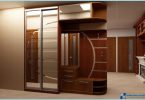The contents
Any house begins with the hallway. This room, which is shown immediately crossing the threshold, the place where they meet and see off friends and relatives. Therefore, it is important to carefully choose not only the materials but also the style of decoration of the hallway to make the interior look nice, cozy and fits harmoniously into the overall design of the house.
It is also worth noting that on the hall floor often remain dirt, sand and earth brought in on the soles of shoes. Therefore, all finishing materials hallway must meet high requirements for durability, abrasion resistance and good perception to frequent wet cleaning.
A finishing material will make the hall is not only beautiful in design but also functional and practical to use? The use of decorative plaster will help to quickly, without much difficulty to finish work, and to equip the hall of your dreams.

What should be the plaster ↑
All components of the material should be only natural and environmentally safe. Mostly decorative plaster contains a marble crumb, particles of different minerals, particularly granite. The consistency of the finished mix should possess high viscosity indices.
Decorative plaster for interior hallway features a variety of textures, the larger particles of the minerals contained in the mixture, the more interesting it can get walls. In order to achieve, almost velvety transparent texture you should choose a plaster mixture containing very fine river sand.

To date, the selection of decorative materials for the decoration of the hallway is extremely wide. Everyone can choose for themselves the best option for an individual project. The most common decorative plasters are mixtures, which in a frozen form mimic natural stone, wood, sand. Also popular are plaster, the texture of which mimics the skin of reptiles or fabric.
Using wax you can achieve additional decorative effect on a finished plastered surface. The properties of wax as a material for finishing is largely similar to the characteristics of acrylic. Both of these material is applied to stone, concrete or wood, well emphasizing their structure.

Plaster ↑
Depending on the received relief plasters can be divided into the following types: structural, textural, Venetian.
Structural plaster allows you to create interesting terrain due to the inclusions of various sizes of particles. The mix of work is heterogeneous in its structure. Striking her on the wall defined movements, creates the desired texture pattern. Plaster mixed with inclusions of large particles of minerals mainly used for finishing the facades. The mixture of small particles well-suited for finishing work in the hallway.

Textured plaster allows you to create terrain and the color on the wall with mixing different shades and the use of special tools. To use a variety of rollers, dies and applicators that allow you to give the plaster figure of wood, masonry, reptile leather, concrete or sand. Also when mixing different shades you can achieve a very interesting play of light.

Venetian plaster the mixture, after painstaking work of applying multiple layers allows you to create amazingly beautiful in appearance surface. Plastered wall may have a matte or glossy finish. To achieve the desired effect master strikes a plaster mix layers, waiting for the drying of each of them. The total number of stacked layers can be twelve pieces. Due to the fact that Venetian plaster contains a very fine marble or onyx dust, overlaying layers of material allows to obtain on the surface of the amazing visual illusion of depth, to see the best in natural stone. An additional layer on the wall to contain the wax which not only protects the finish but also gives the gloss.

Structural paint and flock ↑
Decorative structural paint is a colourful mixture of paint, which contains special microgranules. They burst on the painted wall creating interest to the surface of the colored points.
Floki is a decorative scales made from acrylic. They are applied on the wall with a special adhesive and can be mixed with paint and applied with the spray gun. After drying of the decorative layer, the wall is definitely treated with a special protective compounds.

The combination of finishing materials ↑
As a rule, textured decorative plaster used in the decoration of the lower part of the wall. This part of the surface most exposed to various pollution and mechanical influences. The upper part of the wall well complement the Wallpaper and paint. The same image can be trimmed by columns or piers hallway.

Textured plaster itself is very beautiful finishing material. If a wall split a baguette or a decorative plinth and the surface to fill decorative plaster mixture, you can very easily achieve the visual effect of the treatment on the wall in the hallway with marble, malachite, granite, and other valuable mineral.

Advantages of decorative plasters ↑
Decorative plaster has the following advantages:
- Beauty and amazing ability to mimic various natural materials.
- Practicality in application and durability of.
- Easy to clean.
- Completely non-combustible material.
- Does not change its color structure and form over time, does not absorb odors.
- Well be applied to any surface.
- Some types of decorative plaster perfectly conceal imperfections and defects on the wall.
- The damaged area of plaster can be restored without changing the whole surface.
- Allows for finishing work on top of the applied layer.

Preparation of walls for decorative plaster ↑
From how quality will be carried out preparatory work depends on the lifetime and appearance of finished surfaces. The best option, when preparing walls using reinforced cloth or liquid fillers.

Also a good option to strengthen and stabilize the wall in the hallway will be the use of fiberglass. It is very strong and durable material, however, its installation requires the utmost care and attention. Otherwise, unglued piece of glass is able to completely ruin all the work done on the finish.
In the case where the walls in the hallway decorated with relief plaster mixture, they can be left without leveling.

Technology applying plaster ↑
The process of finishing the hallway decorative plaster shall consist of the following stages:
- On the prepared surface apply the plaster.
- With the help of rollers, spatulas, and other devices creates a certain relief.
- The resulting surface color.
- If you are using Venetian plaster, additional surface treatment with wax.

Each type of plaster requires a special kneading process, and operating conditions. Be sure to specify these details from the seller in the store. As a rule, the walls were decorated with efficiently, should be done in a warm room, with a minimum humidity level. Don’t forget to cover the floor with polyethylene, when in the room are walls.
To start work from the corner, gradually moving around the perimeter of the hall.

How to make a small hallway more ↑
Plaster, laid vertical strokes, can visually increase the ceiling height, and horizontal dashes, make the hallway wider. The most unusual and beautiful patterns on the wall can be done with the help of improvised means: paper, cloth, broom etc.
Be sure to treat the surfaced protective compounds. Thus, it is possible not only to fix the result, but also to make the finish brighter.

About how to perform finishing of the walls in the hallway decorative plaster with a roller, find out more in the next video







